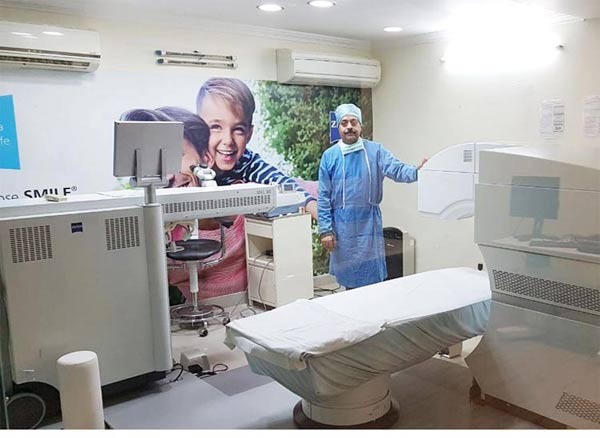Overview
Small incision lenticule extraction (SMILE) is a new refractive procedure used to treat several medical conditions related to the eyes. These medical conditions may be myopia, hyperopia, astigmatism, and presbyopia. In this procedure, a femtosecond laser is used. It is used to create a corneal lenticular (a disc-shaped tissue of the cornea) which is then extracted by making a small hole. It is done without using an excimer laser. Smile Refractive Procedure in Delhi has a minimum complications, increased stability and a short recovery time. Because of these characteristics SMILE Refractive Procedure in Delhi has gained a lot of popularity. This procedure is specially meant for those suffering from a severe case of myopia and astigmatism.
What Are The Benefits Of Smile Refractive Surgery?
- The time taken to completion of SMILE surgeryis 10 to 15 minutes.
- SMILE eye surgery can also correct severe cases of near-sightedness.
- SMILE eye surgery is minimally invasive that uses a smaller incision than traditional laser vision correction surgery. As a result, it results in minimal distortion to the surface of the eye.
- Generally, the SMILE eye surgeryrecovery is faster than other vision correction surgeries. Patients can wear makeup, exercise, and drive the day following the SMILE procedure.
- Patients may experience very few dry eye cases in SMILE surgery compared to LASIK eye surgery.
What Is The Procedure Of Smile Eye Surgery?
The SMILE surgery is performed as follows:-
- First, the surgeon will administer a precise dose of local anaesthetic eye drops. It is used to numb the eyes. It ensures a painless procedure.
- Due to anaesthesia, you would not feel any kind of pain during the surgery.
- Then, the femtosecond laser is used. It places several pulses on the centre of the cornea. It is done with extraordinary precision by the machine.
- Then, the pulses created by the laser on the centre of the cornea generate tiny bubbles (These bubbles are a hundred part of the size of a human hair). These bubbles are created on the tissues that are needed to be removed. The outline of these bubbles shows the outline of the tissue to be removed.
- The laser created the connecting tunnel. It allows the surgeon to extract the tissue. It eventually changes the shape of the cornea, and the vision of the person is improved.
What To Expect After The Smile Refractive Procedure?
- After the completion of the surgery, the vision of the person is improved by almost 80% within a few hours and increases to the capacity of 100% after a few weeks.
- Recovery may be faster, but after completing the SMILE eye surgery, the vision might be slightly blurry. This blurry vision is a temporary and completely normal thing after eye surgery.
- The doctor may call you for an appointment on the next day of the surgery.
- The doctor may call for follow up appointments for 12 months at an interval decided by the surgeon.
- During follow-ups, the doctor will check the progress and healing of the eyes.
Who Should Not Opt For Smile Refractive Surgery?
Some people should not go for SMILE refractive surgery, especially a person having any of these problems:-
- A refractive error that is changing continuously
- Having diseases related to skin or other conditions can delay the healing process.
- A severe case of Glaucoma.
- A severe case of Diabetes.
- Having a disease that causes abrasion to the cornea
- If you have a history ofeye disease
- Suffering from cataract
- Infection in the eye
- Women who are pregnant or nursing
What Are The Complications Of The Smile Refractive Procedure?
Supporting the success and the safety of the surgery, the complications that can arise due to the small incision lenticule extraction (SMILE) procedure are very infrequent. Some of the complications of SMILE eye surgery are:-
- Epithelial abrasion (loss of the outermost layer of the cornea)
- Small tears at the site of the cut
However, any of the above complications had not caused visual impairment in any patients.
- One of the primary complications of SMILE is the loss of suction during the femtosecond laser part of the surgery. It occurs in rare cases, but the suction is regained immediately after losing.
Conclusion
The SMILE procedure is the best recent advancement in the eye care field. It is a minimally invasive surgical procedure. THE Small incision lenticule extraction is the best and most promising alternative to LASIK surgery because of its benefits and reduced recovery time. Also, this method is approved by FDA for treating eye conditions.



 :
:









